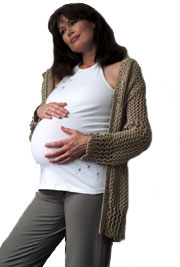- Introduction to smoking during pregnancy
- Prevalence of tobacco use during pregnancy
- Health impact of smoking on pregnancy
Introduction to smoking during pregnancy

Prevalence of tobacco use during pregnancy
Around 17% of Australian women smoke whilst pregnant.
Health impact of smoking on pregnancy
Tobacco smoke contains a number of carcinogens (agents which cause cancer). The carcinogens in tobacco smoke have been shown to accumulate in and damage almost all body organs, including the reproductive organs. Smoking also alters the chemical environment of the smoker’s body while they are consuming tobacco products (e.g. lowers oxygen supply). Thus, smoking can affect a woman’s chances of experiencing a healthy pregnancy even before she conceives, as smoking reduces her chance of becoming pregnant.
There is also strong evidence that exposure to tobacco smoke during pregnancy negatively affects pregnancy outcomes. When a pregnant woman is exposed to tobacco smoke, either from her own, or another person’s cigarette, her foetus is also exposed. There is strong evidence that such exposure is harmful for the foetus, both in the immediate and long term. In the short term, foetal tobacco exposure increases the risk of pregnancy complications (e.g. premature birth) and impairs foetal growth. In the long term, infants born to women who smoked during pregnancy have higher rates of infant and childhood illness and death. The more a woman smokes, the greater the risk of poor pregnancy, infant or childhood health outcomes.

Studies have also shown that smoking affects a woman’s menstrual cycle in ways which reduce fertility. Women who smoke, on average, are more likely to experience irregular menstrual cycles, amenorrhoea and early menopause than women who do not smoke.
Response to in vitro fertilisation
Many infertile women are able to conceive through in vitro fertilisation. However, women who smoke are less likely to become pregnant after an IVF embryo is transferred into their uterus, than women who do not smoke. Evidence from nine studies of the effects of smoking on in vitro fertilisation outcomes showed that the smokers were 34% less likely to become pregnant after IVF treatment than non-smokers. Evidence suggests that the toxins in cigarette smoke negatively affect the ability of an embryo (a fertilised egg) to implant into the lining of the uterus and form a pregnancy. If the embryo does successfully implant, the toxins in cigarette smoke may also affect the embryo’s growth in the very early stages of pregnancy.
A woman’s tobacco smoke exposure during pregnancy affects the development of her foetus from the very early stages of pregnancy and increases the likelihood that she will experience complications during pregnancy.
Australian research shows that women who smoke during pregnancy are 36% more likely to have a miscarriage than those who do not smoke. Some 9% of miscarriages could be prevented by preventing pregnant women from smoking.

In Australia, infants born to smoking women in 2003 were 60% more likely to be delivered preterm than infants born to non-smoking women.
Premature rupture of membranes, placenta praevia and placental abruption
Research has shown that Australian women who smoke are almost twice as likely to experience premature rupture of the membranes (their water breaking prematurely, before they are in labour). Some 21% of cases of premature rupture result from smoking. Smoking during pregnancy also increases the risk of placenta praevia.
In addition, women who smoke during pregnancy are more likely to experience placental abruption than those who don’t smoke. The risk of placental abruption is highest in heavy smokers, who are twice as likely to experience placental abruption compared to women who do not smoke during pregnancy.
Intrauterine growth retardation and low birth weight

The foetuses of smoking women are, on average, 200g lighter than those of non-smoking women. The more a woman smokes the lighter her infant is likely to be, and women who smoke heavily may bear infants up to 500g lighter than average weight babies. In Australia, female smokers are twice as likely to deliver a low birth weight baby than non smokers.
Passive smoking during pregnancy also increases the risk of intrauterine growth retardation and low birth weight. One very large study reported that passive smoking during pregnancy increased the risk of delivering a low weight baby by 32%.

Australian studies show that women who smoke during pregnancy are 33% more likely to bear a stillborn infant. Some 9% of stillbirths in Australia result from smoking.
There is strong evidence that a woman smoking during pregnancy increases her infant’s risk of death in the first four weeks of its life. Australian studies show that infants born to women who smoked during pregnancy are 28% more likely to die within 28 days of birth than infants born to women who did not smoke during pregnancy. Data from other developed countries has also show an increased risk of early death in the infants of women who smoke.
Sudden infant death syndrome (SIDS)
Infants born to mothers who smoke during pregnancy are up to 3 times more likely to die from SIDS than those born to non smoking women. Australian evidence shows a 2.7 times increased risk of SIDS in smokers’ infants, and that 34% of all SIDS cases result from smoking. SIDS is also more common in babies whose parents smoke after childbirth.
Childhood respiratory illnesses including asthma
Smoking during pregnancy increases the risk of a number of childhood respiratory illnesses, even if the child’s parents do not smoke during the first two years of its life. One study reported that 6-12 year old children born to smokers were 25% more likely to wheeze, 18% more likely to have asthma and 13% more likely to cough at night, than infants born to non-smoking parents.
Recently evidence has emerged that there is an association between smoking during pregnancy and digital anomaly (incorrect number of fingers or toes) in the infant. There is no evidence that other congenital abnormalities (e.g. spina bifida) are associated with smoking.
Quitting smoking during pregnancy

It is also important that pregnant women with smoking partners are aware of the adverse effects of their partner’s smoking, and develop strategies to reduce their exposure to their partner’s tobacco smoke. For example the woman’s partner should not to smoke in the house or close to her.
Quitting smoking early in pregnancy reduces the risk of many of the poor maternal and infant outcomes outlined above. For example, a woman who quits smoking during the first trimester of pregnancy is likely to bear an infant of equivalent weight to a woman who never smoked during pregnancy.
Pregnant women and those planning a pregnancy should also be aware of other factors which can affect foetal health during pregnancy, including:
- good nutrition;
- regular exercise;
- abstaining from or reducing alcohol consumption; and
- reducing stress.
Nicotine Replacement Therapy (NRT)
Nicotine replacement therapy (NRT) has been used as a successful intervention for quitting smoking for more than 20 years. Research has indicated NRT can increase the long-term quit rate by 50-70%. As the name suggests, NRT “replaces” nicotine into the bloodstream which is lost when the smoker attempts to quit and has stopped smoking, but without the many thousands of chemicals which are consumed when smoked and are responsible for tobacco related diseases. For this reason, NRT has been thought of as ‘clean nicotine’.
NRT is an efficacious tool for smoking cessation although its safety and efficacy in pregnancy and birth outcomes has not been established. That said, we must keep in mind that the ultimate goal during pregnancy should be to avoid nicotine and tobacco and therefore it is believed that the benefits of tobacco cessation during pregnancy outweigh the risks of using NRT compared to those if the women continued to smoke. While nicotine may be toxic to the foetus, the level of nicotine is reduced and exposure to the other toxic chemicals in cigarettes is avoided with NRT.
In Australia, clinical guidelines recommend the use of NRT in pregnant women who are otherwise unable to quit smoking and psychological interventions have failed.
NRT use in pregnancy must be under the strict recommendation and guidelines of your doctor.
More information on NRT use in pregnancy
More information
 |
For more information about pregnancy, including preconception advice, stages of pregnancy, investigations, complications, living with pregnancy and birth, see Pregnancy. |
 |
For more information about pregnancy planning, including importance of nutrition before pregnancy, being under-weight, being overweight, tobacco exposure and alcohol consumption, see Pregnancy Planning (Preconception Advice). |
 |
For more information on smoking and its health effects, and some useful tools, videos and animations, see Smoking |
References
- Australian Cancer Council. Tobacco in Australia- Facts and issues. Chapter 3: The health effects of active smoking. 2008. [cited 2009, August 22]. Available from: http://www.tobaccoinaustralia.org.au/
- Royal Australian and New Zealand College of Obstetricians and Gynaecologists. Women and smoking. 2008. [cited 2009, August 22]. Available from: http://www.ranzcog.edu.au/publications/collegestatements.shtml#CObs
- Augood, C. Duckitt, K. Templeton, A.A. Smoking and female infertility: a systematic review and meta-analysis. Human Reprod. 1998. 13(6):1532-9.
- Walsh, R. A. Lowe, J.B. Hopkins, P.J. Quitting smoking in pregnancy. MJA. 2001;175:320-3.
- Bouyer. J. Coste, J. Shojaei, T. Risk factors for Ectopic Pregnancy: A Comprehensive Analysis Based on a Large Case-Control, Population-based study in France.Am J Epi. 2003;157(3):185-94.
- Sub commission on Nutrition. 4th Report on the World Nutrition Situation: Nutrition throughout the lifecycle. 20. [accessed 2009, November 11]. Available from: http://collections.infocollections.org/ukedu/en/d/Jh1313e/
- US Department of Health and Human Services. The health consequences of smoking. A report of the Surgeon General. 2004. [cited 2009, August 28] Available from: http://www.surgeongeneral.gov/library/smokingconsequences/
- Leonardi-Bee, J. Smyth, A. Britton, J. Coleman, T. Environmental tobacco smoke and fetal health: systematic review and meta-analysis. Arch Dis Childhood Fetal Neonatal Ed. 2008;93:F351-61.
- Pattenden, S. Antova, T. Neuberger, M. et al. Parental smoking and children’s respiratory health: independent effects of prenatal and postnatal exposure. Tob Control. 2006;15:294-301.
- Lumley J, Oliver S, Chamberlain C, Oakley L. Interventions for promoting smoking cessation during pregnancy. Cochrane Database Syst Rev. 2004, Issue 4. Art No.: CD001055.
- British Columbia Reproductive Care Program. Tobacco use in the perinatal period. 2006. [cited 2009, August 22]. Available from: http://www.bcphp.ca/sites/bcrcp/files/Guidelines/SubstanceUse/TobaccoGuidelines.pdf
- Orleans, T. Barker, D.C. Kaufman, N.J. Marx, J.F. Helping pregnant smokers quit: meeting the challenge in the next decade. Tob Control. 2000;Supp3:iii6-11.
- Piper ME, Smith SS, Schlam TR, et al. A randomized placebo-controlled clinical trial of 5 smoking cessation pharmacotherapies. Archives Gen Psychiat. 2009; 66(11): 1253-62. [Abstract] http://www.citeulike.org/user/kevinemamy/article/6058204
- Tobacco in Australia: Smoking Cessation 7.16 Pharmacotherapy [online]. The Cancer Council, 2010 [cited Oct 2010]. Available from: URL link
http://www.tobaccoinaustralia.org.au/chapter-7-cessation/7-16-pharmacotherapy - Apelberg BJ, Onicescu G, Avila-Tang E, Samet JM. Estimating the Risks and Benefits of Nicotine Replacement Therapy for Smoking Cessation in the United States. Am J Public Health. 2010; 100: 341–348. [Abstract]
- Lassen TH, Madsenb M, Skovgaardc LT, Strandberg-Larsenb K, Olsend J, Andersenb AN. Maternal use of nicotine replacement therapy during pregnancy and offspring birthweight: a study within the Danish National Birth Cohort. Paediat Perinatal Epidemiol. 2010; 24: 272–281. [Abstract]
- National clinical guidelines for the management of drug use during pregnancy, birth and the early development years of the newborn [online]. NSW Department of Health, 2006 [cited September 25, 2010]. Available from: URL link
- Forest, S. Controversy and Evidence about Nicotine Replacement Therapy in Pregnancy. American J Mat/Child Nurse. 2010; 25(2): 89 – 95. [Abstract]
All content and media on the HealthEngine Blog is created and published online for informational purposes only. It is not intended to be a substitute for professional medical advice and should not be relied on as health or personal advice. Always seek the guidance of your doctor or other qualified health professional with any questions you may have regarding your health or a medical condition. Never disregard the advice of a medical professional, or delay in seeking it because of something you have read on this Website. If you think you may have a medical emergency, call your doctor, go to the nearest hospital emergency department, or call the emergency services immediately.







